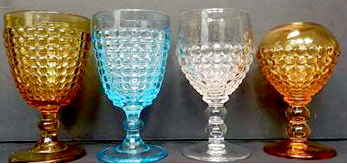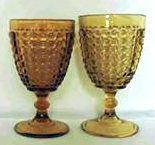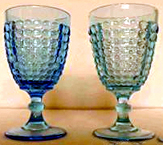MORE

THOUSAND EYE OMN SENSATION
This page is brought to you by PatternGlass.com with a
Tip of the Hat to our glassie friend, Haileta Willing,
who shared these photos with us.
And with Darryl Reilly and Bill Jenks for additional information.
| GOBLETS: |
 |
| Amber L G Wright Reproduction; the difference is the weight, slightly different in height & colors. | Original issue in blue by Adams' Glass Co. ca. 1885. | Clear New Martinsville Glass 1942 was used to produce the amber for L G Wright by turning the top inward for the Ivy Bowl. | Amber Ivy bowl by New Martinsville. |
 |
 |
| L G Wright Adams Glass Co. | L G Wright Adams Glass Co. |
According to "Identifying Pattern Glass Reproductions" by Jenks, Luna & Reilly, the simplest way to differentiate between old and new goblets is to measure the length of the stem. The original stems measure 2 5/8" from the base of the bowl to the bottom of the foot. Reproductions measure a trifle over 2 3/8"to a scant 2 1/2". |
Go to where original Thousand Eye pieces are HERE.
| Reissue vs. Reproduction - a Review In the world of glass collecting the difference in what is a repro-duction and what is a re-issue is debated quite often, especially with regard to patterns such as Recol-lection. To help clarify the issue here are some definitions we use. A reissue is a pattern that is produced subsequent to its first production, regardless of the time span and regardless of the maker without any changes to the original molds or plates. A reproduction is a copy or imitation of an original pattern which was not produced from the original molds or plates. |
 |
 |
 |